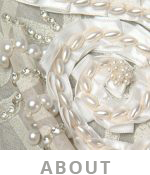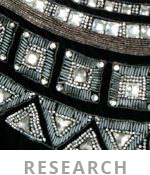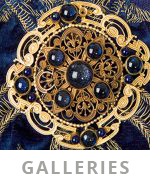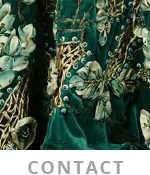Apr 16, 2017
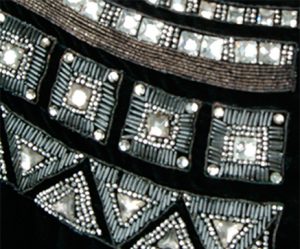
Black evening gown of transparent silk velvet with wide band of beading at neck and sleeves. Knee-high cartridge pleated ruffle at side and back. Original gauntlets and belt are missing.
This gown was designed by Adrian for Metro Goldwin Mayer and worn by Greta Garbo in the film Inspiration.
Adrian Adolph Greenberg (March 3, 1903 — September 13, 1959), widely known as Adrian, was an American costume designer whose most famous costumes were for The Wizard of Oz and other Metro-Goldwyn-Mayer films of the 1930s and 1940s. During his career, he designed costumes for over 250 films and his screen credits usually read as “Gowns by Adrian”. On occasion, he was credited as Gilbert Adrian, a combination of his father’s forename and his own.
Adrian was hired by Rudolph Valentino’s wife Natacha Rambova to design costumes for A Sainted Devil in 1924. He would also design for Rambova’s film, What Price Beauty? (1925). Adrian became head costume designer for Cecil B. DeMille’s independent film studio. In 1928, Cecil B. DeMille moved temporarily to Metro-Goldwyn-Mayer and Adrian was hired as chief costume designer at the studio. While DeMille eventually returned to Paramount, Adrian stayed on at MGM. In his career at that studio, Adrian designed costumes for over 200 films.
Adrian left MGM in 1941 to set up his own independent fashion house, though he still worked closely with Hollywood. A serious heart attack in 1952 forced the closure of Adrian, Ltd. in Beverly Hills. In 1959 he was asked to design costumes for the upcoming Broadway musical Camelot. In the early stages of this project, Adrian died suddenly of a heart attack at the age of 56.
Apr 16, 2017
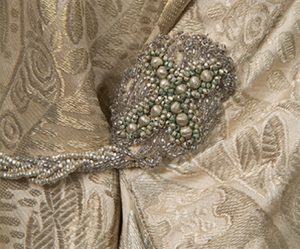
This evening gown of silver silk brocade gown features a train. It is embellished with silver and crystal beads, a favorite color combination of the original owner, Minnie Cassatt, granddaughter of A. J. Drexel, founder of Drexel University. Label: :Cheruit, 21, Place Vendome, Paris. SIZE: 63 1/4″
Mme Madeleine Chéruit was among the foremost couturiers of her generation, and one of the first women to control a major French fashion house.Her salon operated in the Place Vendôme in Paris under the name Chéruit from 1906 to 1935. Cheruit, whose mother was a seamstress, received her early professional training in dressmaking in the late 1880s with Raudnitz & Cie, located in the heart of Paris. Mme Chéruit’s talent, alongside that of her sister Marie Huet, was such that they ascended to leading positions within the firm. By 1900, labels sewn into clothes created at Raudnitz bore the words, Raudnitz & Cie, Huet & Chéruit Srs., 21, Place Vendôme, Paris – with the names of the sisters in more prominent type.[11] By 1905, the firm’s labels read, Huet & Chéruit, Anc.ne Mon. Raudnitz & Cie (“Huet and Chéruit, formerly Mr. Raudnitz and Co.”).
The next year, 1906, the fashion house with its more than 100 employees became her own, and was rechristened “Chéruit.”[13] The salon occupied the distinguished hôtel de Fontpertuis on Place Vendôme, built in the 17th century by Pierre Bullet. By 1910 Mme. Chéruit was one of the most celebrated designers in Paris, her name mentioned by the ubiquitous Marcel Proust in his Remembrance of Things Past. As one of the leaders of French style, Chéruit and her house of couture took fashion from the Belle Époque through the Jazz Age. In 1912, Mme. Chéruit signed a contract to collaborate with Lucien Vogel to produce the fashion magazine, La Gazette du Bon Ton. Six other top Paris designers – Georges Doeuillet, Jacques Doucet, Jeanne Paquin, Paul Poiret, Redfern, and the House of Worth – joined the project.
Vogel hired leading Art Deco artists to fill the journal’s pages with striking illustrations of the designers’ fashions along with essays by noted writers.Pierre Brissaud created most of the illustrations of her work that appeared in the pages of La Gazette du Bon Ton.Mme Chéruit’s aesthetic was traditionally feminine, incorporating soft fabrics, pastel colors and rare embroideries, but she was innovative in line and cut. In late 1911 she introduced the pannier gown, full at the hips and tapering to an ankle-length hem, which recalled French court fashions of the 18th century.
Delicate evening dresses may have been her forte, but she was also adept at elegant street wear, and by 1914 her walking suits and afternoon gowns were fashion staples. In addition to evening gowns, the house was known for chic cinema wraps, furs, lingerie, wedding trousseaus, even children’s clothing in rayon. Fascinated by the effect of light on fabric, Chéruit and her designers worked with taffeta, lamé, and gauze, and followed the latest trends in art. With the move toward simpler fashions after the war, typified by such designers as Jean Patou and Coco Chanel. Mme. Cheruit’s taste for opulence lost appeal and she retired in 1923. Chéruit died in 1955. -Wikipedia
Apr 16, 2017
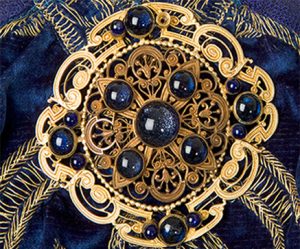
This blue silk velvet evening dress is embellished with gold embroidery and custom made jeweled medallions. It originally belonged to Minnie Cassatt, granddaughter of A.J. Drexel, founder of Drexel University.
Callot Soeurs opened in 1895 at 24, rue Taitbout in Paris, France. It was operated by the four Callot sisters: Marie Callot Gerber, Marthe Callot Bertrand, Regina Callot Tennyson-Chantrell and Joséphine Callot Crimont.The eldest sister, Marie, was trained in dressmaking, having earlier worked for Raudnitz and Co., prominent Parisian dressmakers, and they were all taught by their mother, a lacemaker. The sisters began working with antique laces and ribbons to enhance blouses and lingerie. Their success led to an expansion into other clothing.
In 1900, they were featured at the Paris World’s Fair. That year, they had a staff of two hundred and did two million francs in sales. By 1901, they had tripled their workforce and doubled their sales. In 1916, Henri Bendel was the largest buyer of Callot Soeurs in New York City.[6] That same year, American Vogue dubbed the sisters the Three Fates, and declared them “foremost among the powers that rule the destinies of a woman’s life and increase the income of France.In 1919, Callot Soeurs moved to larger premises at 9-11 Avenue Matignon.
In 1928, Pierre Gerber, Marie Callot Gerber’s son, took over the business but could not survive in the highly competitive market and, in 1937, the House of Callot Soeurs closed and was absorbed into the House of Calvet (Marie-Louise Calvet);[2] under the Callot label. However, World War II made matters difficult in France. Similarly to what happened with the House of Vionnet in 1939, Calvet and the Callot label finally closed in 1952.
The couturier Madeleine Vionnet was head seamstress at Callot.[4] It was here that she refined her technique in couture. Madeleine Vionnet explained that “Without the example of the Callot Soeurs, I would have continued to make Fords. It is because of them that I have been able to make Rolls-Royces.” -Wikipedia


